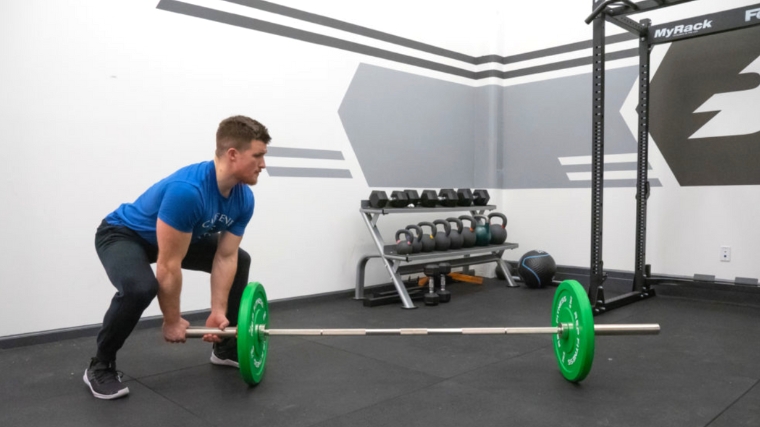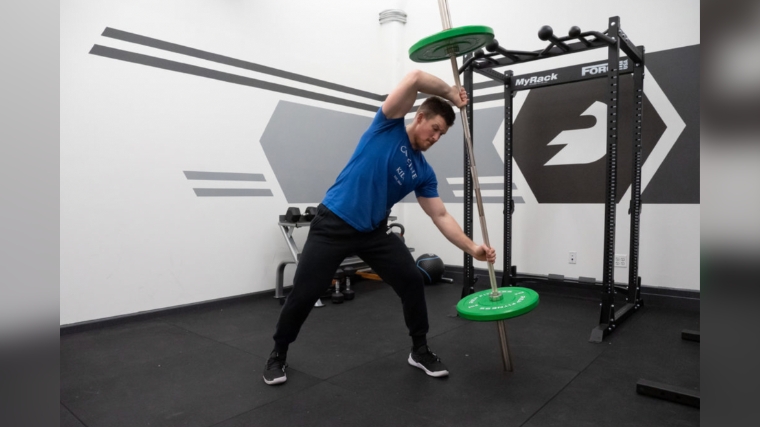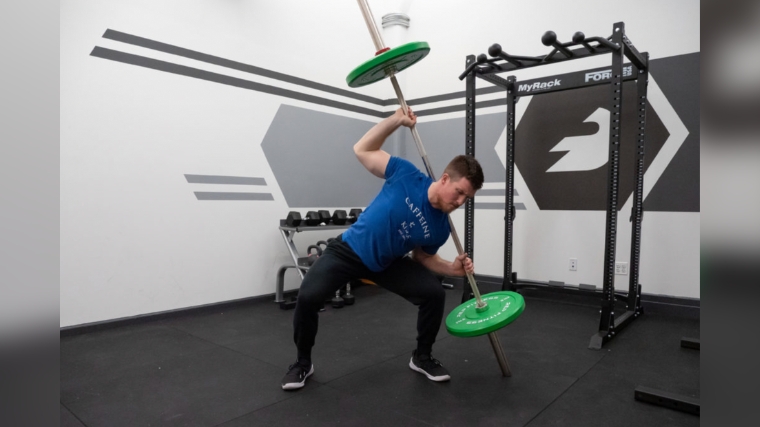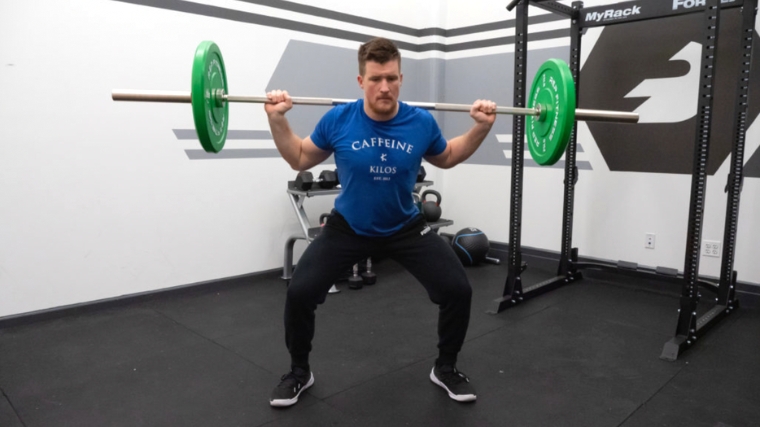The biggest lifting legends often have exercises named after them. Nineteenth-century lifter Henry “Milo” Steinborn, born in 1893, is no exception. One of the most influential strongmen and weightlifters of his time is credited with creating this unique — and risky — version of the squat.
The Steinborn squat literally turns the squat sideways. The complex lift requires an athlete to stand the barbell up so that is perpendicular to the ground and position themselves underneath. Then, they’ll pull the barbell like a lever down across their upper back and receive the load in the squatted position.
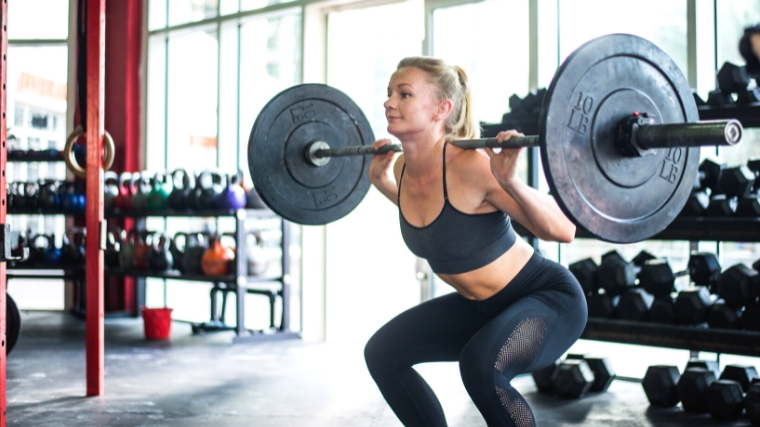
From there, the lifter must stand the weight up, perform some squats, and return the barbell to the floor in the same reverse fashion that they picked it up. Sound complicated? It is. But don’t worry — here’s everything you need to know about the Steinborn squat, including how to do it.
- How to Do the Steinborn Squat
- Steinborn Squat Sets and Reps
- Common Steinborn Squat Mistakes
- Steinborn Squat Variations
- Steinborn Squat Alternatives
- Muscles Worked by the Steinborn Squat
- Benefits of the Steinborn Squat
- Who Should Do the Steinborn Squat
- Frequently Asked Questions
Editor’s Note: The content on BarBend is meant to be informative in nature, but it should not be taken as medical advice. When starting a new training regimen and/or diet, it is always a good idea to consult with a trusted medical professional. We are not a medical resource. The opinions and articles on this site are not intended for use as diagnosis, prevention, and/or treatment of health problems. They are not substitutes for consulting a qualified medical professional.
How to Do the Steinborn Squat
It’s no coincidence that this tricky squat was created by an absolute legend. It’s incredibly difficult to pull off, even with an empty barbell. If you’ve got the mobility, strength, and patience it takes to attempt this beast of a lift, here’s how to do it.
Step 1 — Grab the Bar

Start by standing perpendicular to the end of the barbell. Squat down, grabbing one end of the barbell with both hands.
Coach’s Tip: Set your back like you’re doing a deadlift, keeping your back neutral and your hips back in your squat.
Step 2 — Lift One End Up

Walk the barbell up so that it becomes vertical to the ground. Use your legs and lift up like you were doing a deadlift.
Coach’s Tip: Be careful not to let the bar roll on the ground.
Step 3 — Set Your Grip

Take your bottom hand and grab the bar in the same spot at which you would establish your grip in a back squat. Squat down and get yourself fitted to the barbell, which often means your lead foot is close to the weight plates on the ground.
Coach’s Tip: Use your core to resist excessive spinal lateral flexion and/or movement of the bar.
Step 4 — Pull Yourself (and the Barbell) Down

With your feet and hands secured, pull the barbell down into your body and begin to sit into a deep squat.
The bar will move and/or slide if you do not properly position yourself during step three, so move extra cautiously here. Additionally, be sure to be fluid as you drop into a deep squat.
Coach’s Tip: This step happens quickly, so be ready to take the load securely onto your back.
Step 5 — Sit into a Deep Squat

Sit deep into a strong, low, and stable squat.
Be sure to keep your chest up and your core tight. Prepare yourself to stand up.
Coach’s Tip: Be sure you are able to sit in a deep squat prior to training the Steinborn squat.
Step 6 — Stand Up

Once you have stabilized the load on the bar, simply stand up to the top of the squat position.
You can then dump the barbell off your back or walk it into the rack.
Coach’s Tip: If you’re up for a challenge, you can reverse steps one through six, as you would with a Turkish get-up. Just be sure you know the steps very well before attempting this.
Steinborn Squat Sets and Reps
Like the Steinborn squat’s cousin, the Turkish get-up, you want to focus on movement quality rather than higher repetitions. Keep your rep scheme very low — even when working with lighter weight — to keep your focus on impeccable form.
- For Movement Integrity: Perform two to five sets of one to two reps per side.
- For Strength: Do three to five sets of one to two reps per side.
Common Steinborn Squat Mistakes
Any heavily-loaded lift that requires lateral flexion will likely be extra challenging for a lifter who’s used to moving barbells straight up and down. With any unfamiliar exercise, the likelihood of error gets pretty high. Here are the big mistakes you want to steer clear of with the Steinborn squat.
Failing to Set Up Properly
Make sure that when you begin to transition from a side bend into a deep squat, you’re absolutely ready to shoulder the load. Make sure your feet are set in your preferred squat stance. You might even want to keep them slightly wider than normal — a wider base of support may help improve your balance.
Make sure your hands are also in a solid position, with your lats engaged, your back neutral, and your core braced. The more prepared your body is to handle an oncoming load, the better.
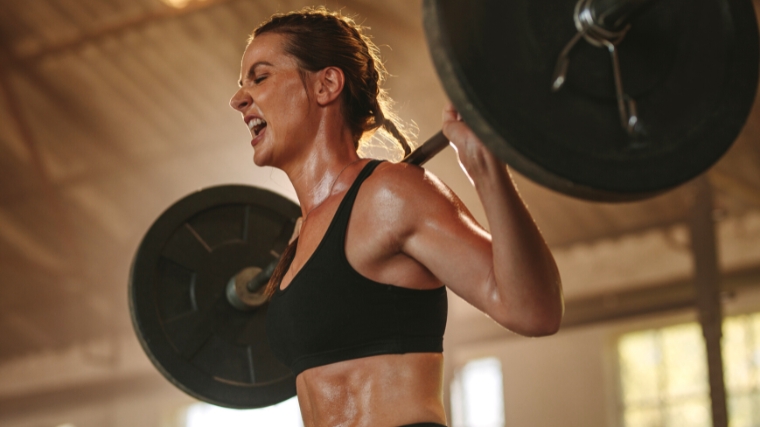
Focus on moving slowly but with confidence. Hesitation during this movement can be costly, so perform plenty of reps with an empty or lightly-loaded barbell before progressing on to performing this movement for strength.
Doing Too Many Reps
Even if your load is light, you might be guilty of performing too many reps. The Steinborn squat is not a movement you want to perform to develop greater endurance. Performing this lift under too much fatigue will almost inevitably result in less-than-optimal form.
Since this exercise takes you through unorthodox movements under a potentially heavy load, maintaining perfect form is especially essential for your safety.
Keep your rep scheme extremely low — one to two reps per side — to help minimize the risk of injury.
Lifting Too Heavy
The goal with this lift is to be able to develop strength in an often underutilized movement pattern. That said, it is possible to have too much of a good thing. Slapping on too many weight plates for this move is a recipe for disaster.
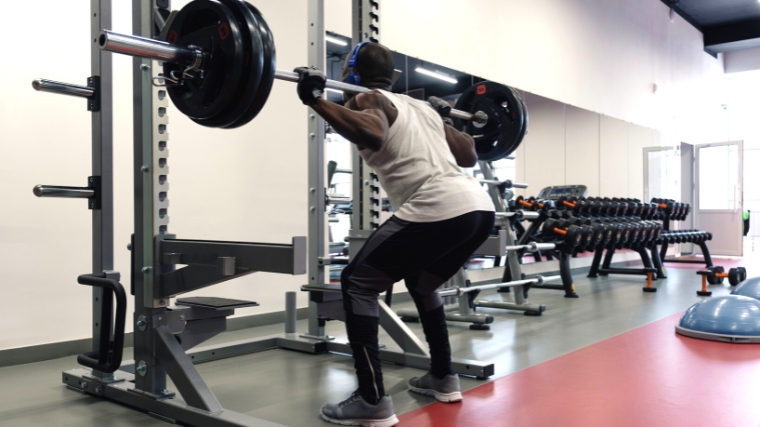
Avoid slapping on a lot of plates before you’re ready. This may be difficult to judge since your rep scheme will consistently remain low. To assess when you’re ready to increase your load, judge by how many sets you can complete with ease using your current load. When you get to the higher end of total sets (four or five) with clean form, consider adding weight.
When you are ready to add a heavy load, make sure your barbell collars are extremely secure. The last thing you want is your weight plates clattering to the floor because your barbell collars weren’t ready to handle a vertical load.
Steinborn Squat Variations
A move like the lunge has so many variations that it’s like they’re sibling exercises rather than cousins. The Steinborn squat, however, doesn’t have too many one-to-one variations. But the Turkish get-up and Steinborn bend in particular have many fairly direct comparisons to this squat.
Turkish Get-Up
The Turkish get-up is a total-body movement that — like the Steinborn squat — goes through many discreet steps to make up one exercise. This exercise will also have you controlling a load held laterally. That makes this a great prerequisite for performing the Steinborn squat.
[Read More: The Best Leg Exercises for Your Next Leg Day]
As with the Steinborn squat, you can load the Turkish get-up fairly heavily. Just make sure you’re only progressing when you’re ready. Mastering this movement step-by-step is more important than loading it right away.
Anderson Squat
The Anderson squat will also have you starting in an unusual position. Similar to a pin squat or a pause squat, the Anderson squat’s emphasis is on improving your deep squat.
This move is another excellent prerequisite for the Steinborn squat. Movements that help you develop strength and confidence at the bottom of your squat can help carry over into a safer, more stable Steinborn squat.
Steinborn Bend
The Steinborn bend is pretty much what it sounds like. You won’t be going into a full squat here. Instead, you’ll simply be bending side-to-side — laterally flexing your core — with a barbell on your back.
Think about performing a good morning — except laterally. You’ll keep the bar securely pinned on your back as you slowly and deliberately lean to the side. Again, make sure your barbell collars are extremely strong and secure.
Steinborn Squat Alternatives
If the Steinborn squat isn’t accessible to you yet — or if you’re still working on perfecting those variations — you might need some alternatives. While these moves won’t give you the entire Steinborn squat experience, you can mix and match them for a full-body challenge.
Single-Arm Windmill
The half-kneeling version of this move is one component of the Turkish get-up. By isolating this part of the movement, you can train yourself to get a lot more comfortable with lateral flexion.
Being able to confidently bend to the side under load is an essential piece of the Steinborn squat. If doing so with a barbell is too much for you right now, grab a kettlebell or a dumbbell and practice single-arm windmills instead.
Cossack Squat
The Cossack squat can be a great movement to increase hip mobility and strength. You need both of these in spades to pull off a successful Steinborn squat.
Another benefit of the Cossack squat is fighting off any side-to-side strength and mobility imbalances. Identifying and reducing these asymmetries as much as possible is critical to developing a strong, stable Steinborn squat.
[RELATED: Best Mobility Exercises]
Fireman Carry
The fireman carry is a basic movement that has a high degree of functionality for life and sports. You can do this in many commercial gyms, and it’s much more accessible than a Steinborn squat.
With the fireman carry, you’ll be able to develop incredible unilateral strength — an essential part of the Steinborn squat. By offsetting the load to one side of your body, the fireman carry will make your core very strong at resisting lateral flexion. This is often regarded as a safer — but extremely effective — alternative to loading your spine laterally.
Muscles Worked by the Steinborn Squat
The Steinborn squat is going to work your entire body from stem to stern. Even your toes will be gripping the ground extra hard. Here, you’ll find the prime movers for this head-to-toe move.
Back (Erectors, Latissimus Dorsi, Traps)
Your entire back will really kick in here. You’ll need your lats and traps to help lock the bar into place. Then, your erectors will need to help with keeping your entire back stable during the lateral flexion and deep squat components.
Quadriceps
Without strong quads, you’re not going to be able to stand this one up — plain and simple. You’ll need to stabilize through the fronts of your thighs while you’re preparing for liftoff. Once you’ve got the bar to standing, you’ll need your quads to help come out of your deep squat.
Hamstrings
As with a regular squat, your hamstrings will play a critical role in the Steinborn squat. Make sure you warm them up beforehand, as the opposite leg will likely get a solid loaded stretch in while you’re transitioning to a deep squat.
Glutes
You can’t have a squat without solid glute engagement. Not only will your glutes participate in the full squat portion of this lift — they’ll also help you stabilize your body relative to the barbell when it’s in the vertical position.
Adductors
Your adductors need to be both strong and mobile to handle this lift, especially under heavy load. Once you sink into your deep squat, your adductors will also assist with your regularly-scheduled squatting.
Obliques
Your obliques play an absolutely crucial role here. Lateral flexion is the name of the game with the Steinborn squat, and without strong obliques, you’re going to be running on empty.
Rear Delts
While your rear delts help pin the bar to your back under normal squatting circumstances, they’ll work overtime here. You’ll be reaching up and to the side to grab the bar to set up your lift, meaning that your rear delts will work overtime.
Benefits of the Steinborn Squat
If you’re able to do the Steinborn squat, you should be prepared to reap some serious benefits. From lateral loading strength to superb odd object training — with a barbell — here’s what to expect from this movement.
Real-World Functional Strength
The ability to pick odd objects up and hoist them overhead or onto the body is one of the most beneficial skills you can develop in the gym. If you’re a weightlifter or powerlifter — or even a dedicated, noncompetitive gymgoer — you’re likely only used to up-and-down barbell movements.

Tossing some frontal plane exercises — side-to-side movement — into the mix will increase your strength overall. It will also help boost your ability to grapple with different types of objects and obstacles that may come up in training or in life. CrossFitters and strongman athletes may find this kind of training particularly applicable to their sports.
Increase Lateral Strength and Stability
The Steinborn squat puts your core under potentially very heavy loads in the frontal plane. This means you’re moving laterally while under load. This has a tremendous effect on your oblique strength and core stability.
When you do the Steinborn squat, you’re combating side-to-side imbalances by challenging yourself to handle a load the same way on both sides of your body. It’s also rare to load your obliques.
This will help your core handle more stress and become more efficient at transmitting force under any circumstances. That’s exactly what you want when you’re trying to press, deadlift, or squat heavy.
Increasing Concentric Strength
The ability to move loads from a dead stop is key to most strength and power sports. As the lifter catches the load in the bottom position, they must stabilize their body and bar. Only after stabilization can the lifter perform a concentric-based squat from the deepest of positions.
Over time, increasing static strength — raw strength with no momentum or stretch reflex — can increase force production at your end ranges of motion. This will work wonders for improving your power and enhancing your overall performance.
Neurological Adaptation
Stressing your body via new movements can be one of the most impactful things you can do for maximal strength, muscle-building, and neurological development. By introducing new stressors from various angles, you have the ability to elicit total-body adaptations that can then be transferred back into your regular routine.
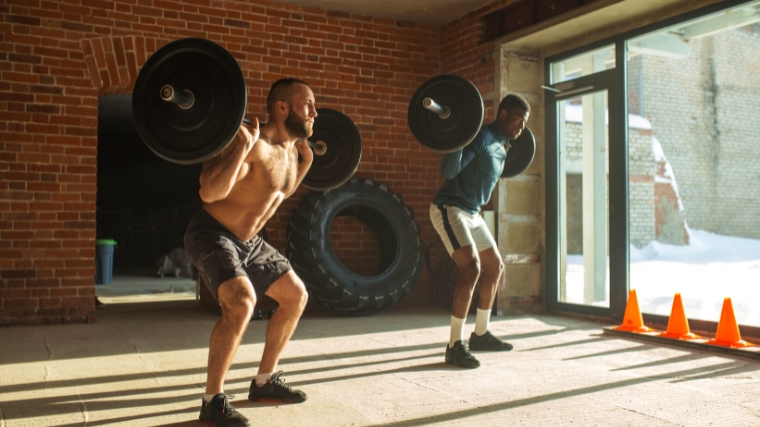
By performing new challenging movements correctly, you stimulate new motor units and create new synapses between the brain, nerve cells, and muscle units. All of this can add to your pool of strength and performance potential.
Who Should Do the Steinborn Squat
While the Steinborn squat isn’t for everyone — namely, beginners — there are many lifters that can benefit tremendously from it. While powerlifters and weightlifters might enjoy the lateral strength and stability benefits in the offseason, strongman and CrossFit athletes may get the most out of this move.
Strongman Athletes
Being able to move odd objects is the name of the game in strongman training and competitions. While the barbell is by definition not an odd object — it’s the standard for most strength sports movements — the Steinborn squat is certainly an odd movement pattern. This transfers over very well to a strongman athlete’s skill set.
CrossFitters
In CrossFit, athletes often talk about general physical preparedness — the ability to conquer any and all physical obstacles that come your way. While that’s generally referring to conditioning and a high-level work capacity, the Steinborn squat fits this bill. Because it’s a unique movement that challenges the entire body, it fits right into a CrossFitter’s repertoire.
Advanced Gymgoers
If you’ve got some gym time under your weightlifting belt, the Steinborn squat might be calling to you from across the weight room. As long as you have plenty of experience in the squat rack, taking this movement for a ride can help you bring your strength, stability, and power to the next level.
Squat, But Sideways
The Steinborn squat may look like a carnival trick rather than a strength training exercise. While it’s certainly not a traditional move, the Steinborn squat comes with some pretty traditional benefits. Think: increased total-body strength and coordination, improved core stability, and a stronger mind-muscle connection.
If you’re ready to add the Steinborn squat to your routine, you might be hungry to load it heavily. Make sure your form is locked in and that you’re progressively overloading your movement to ensure gradual improvement. With a strong set of barbell collars, you’ll be in business. Steinborn squat away.
FAQs
The Steinborn squat is a particularly tricky beast — it’s reasonable to still have questions. We still have answers.
Should I do the Steinborn squat?
If you’re able to perform heavy squats with a full range of motion without a problem, you have a strong core, and good hip and thoracic mobility, you can likely try the Steinborn squat.
Start by performing Turkish get-ups and — most importantly — Steinborn bends. Once you’ve mastered those, do some Steinborn squats with an empty barbell. Continue from there.
What moves do I have to learn before I can do the Steinborn squat?
In addition to impeccable deep squats, you’ll want to master the Turkish get-up before trying the Steinborn squat. This will help you get used to the need to flow through multiple complicated steps through different planes of motion — all in the course of one rep.
Then, make sure you can perform Steinborn bends. Once you can do those comfortably under load, it’ll be time to move onto the Steinborn squat.
Are Steinborn squats safe?
There is some level of risk to any exercise in the gym — including regular squats. That said, the Steinborn squat is a movement that many strength athletes find unusual and difficult. Many programs do not include heavily loaded side-to-side movements.
Because of this, inexperienced athletes may progress too quickly with the Steinborn squat. They might risk hurting themselves in a movement they’re not used to.
That said, if you have the requisite mobility, strength, and prerequisite skills — like the deep squat, Steinborn bend, and Turkish get-up — you can likely perform the Steinborn squat safely. Make sure to practice extensively with an unloaded barbell and progress very gradually from their to minimize injury risk.
Featured Image: Mike Dewar
